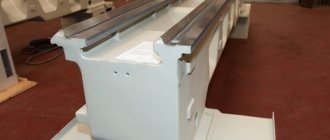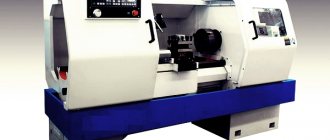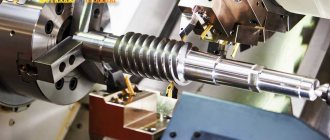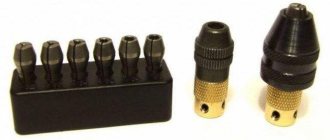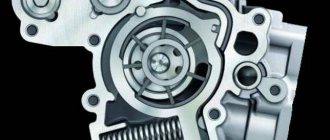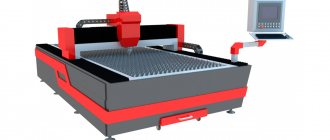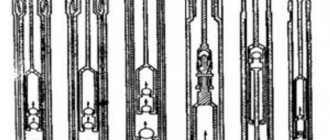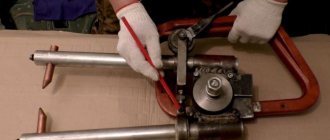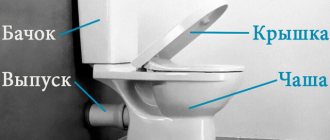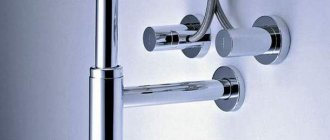Design of a sheet bending machine and its improvement
The installation of a manual sheet metal bending machine can be easily improved. To build a sheet bending machine, this scheme is used:
- Pillow made of wood;
- The main beam is made of channel 10−130 mm;
- Cheek, for the production of which a sheet 7-9 mm wide is used;
- Manufacture sheet subjected to finishing;
- A pressure beam made of 70-90 mm corners connected by welding;
- Rod for rotating the traverse (made from an iron rod with a diameter of 11 mm);
- The spacer itself is an angle with dimensions of 90-110 mm;
- The handle of the device is made of a rod with a diameter of 12 mm.
The sheet bending traverse, which according to the initial drawing is planned to be made from a corner, conventionally shows an option made from a channel. Such an improvement will several times increase the endurance of the traverse, which, when using a corner, at a certain moment will certainly bend in the center and will not form a high-quality sheet bend in this place.
Replacing with a channel will allow you to do not 250 bends without straightening or replacing the provided element (which is quite a bit for more or less constructive work), but more than 1400.
The design of this home-built sheet metal bending machine can be further improved, making it more efficient and versatile.
The second option allows you to understand in more detail the installation of a homemade sheet bender:
- A homemade clamp made from a suitable angle (50-70 mm) and a screw with a heel and a knob;
- Cheek;
- Beam acting as the reference point of the machine;
- Pressure beam bracket made from 120 mm angle iron;
- The pressing beam of the sheet bender itself;
- Traverse rotation axis;
- The traverse itself;
- Strengthening the pressure beam.
Below is a diagram of increasing the pressure bar. However, if you initially use a rather powerful corner as a clamp, and you don’t plan to bend extremely thick sheets on your sheet bending machine, then you can do without reinforcing the clamping bar using the described method.
In order to extend the service life of the pressure beam and make it comparable to the service life of the traverse, it is necessary to increase the provided structural element, which from the very beginning according to the drawing is made of a corner, with a base made of a metal strip with dimensions of 17x90 mm.
The front edge of the provided base must be given an angle of 45 degrees in order to level its area with the plane of the pressing corner itself, and specifically the working edge of the provided element must be chamfered about 3 millimeters. These measures will allow the clamp metal to act not on bending (which is extremely inappropriate), but on compression, thereby increasing the service time without repair many times:
- A special 61 angle bracket attached to the rear flange of the main clamp angle will keep it from bending upward.
- You should also think about milling the lower plane of the pressure beam, which forms the bend.
- The unevenness of the provided plane, according to generally accepted rules, should not exceed fifty percent of the thickness of the workpiece being bent.
- Otherwise, it will not be possible to bend the blank evenly, without a swollen fold line.
It is necessary to keep in mind that you need to submit a beam for milling only when it already has all the welds, since their execution leads to a change in the geometric characteristics of the structure.
Types of sheet benders
Bending machines are divided according to various factors. Depending on the type of drive, the following types of equipment can be distinguished:
- Manual - models installed in private workshops and enterprises. They consist of a pressure plate, a work table, and a bending mechanism that works after transmitting human force through special handles. To work with the equipment you do not need to have additional skills.
- Mechanical - structures that consist of a flywheel, a moving shaft, and pressure plates. To bend the workpiece, you need to spin the flywheel.
- Hydraulic - a system that operates using fluid. Under pressure, it begins to act on a hydraulic cylinder, which bends the sheet.
- Electromechanical - consists of an electric motor, which, using belts and a set of gears, transmits force to a clamping bar, a moving mechanism. Allows you to bend workpieces of large thickness.
- Pneumatic - mechanisms operating using pneumatic cylinders.
- Electromagnetic - modern equipment on which high-power electromagnets are installed. After turning on the machine, they begin to move the bending bar to the specified angle.
Compact models of sheet benders should be included in a separate group. They can be used on a construction site. The downside is the insufficient size and power, which does not allow bending sheets of large sizes and thickness.
Manual sheet bending machine
Do-it-yourself manual sheet bender for thick sheets
To make such a model of equipment, it is better to take angles and channels, be sure to remove all rust. You can’t do without a welding machine.
The standard design consists of:
- grounds,
- pressing,
- crimping punch.
It is better to use a channel No. 6.5 or No. 8 for the base, a channel No. 5 for clamping, and a corner No. 5 for the punch. The thicker the walls, the better.
The dimensions of the punch and clamp are made 55 mm shorter than the base. According to the description and drawings, it is easy to make such a sheet bending machine with your own hands:
- In the clamping part, drill holes for the bolts strictly along the axis at a distance of 30 cm from the ends.
- Bend the reinforcement with a diameter of 15 mm in the form of a lever and weld it to the corners.
- At the ends of the punch and base, chamfer 7*45° along the edges.
- Add 5 mm thick sheet steel cheeks to the base.
- Drill holes with a diameter of 8.5 mm in the base and cut threads for screwing in clamping bolts.
- Install wings or wrenches on the bolt heads.
How to make a manual sheet bender with your own hands - drawings with step-by-step descriptions and video of work
No matter the skill and experience, it is almost impossible to bend a part of a sheet with a mallet and a mandrel without deforming it. On the Internet you can find many instructions, drawings, photos of homemade sheet benders of various options.
For the traverse device it is enough:
- 4 meters of steel angle with a 50 mm side,
- ball joint for a vehicle equipped with a mounting bracket,
- stabilizer rods with a diameter of 10 mm,
- Bulgarians,
- drills,
- apparatus for electric welding.
The procedure for making a sheet bending machine with your own hands according to the drawings
- Use a grinder to cut pieces of steel angle, each 1 m long.
- Cut two loops from the bracket for the movable crossbar.
- Make an axis from the stabilizer link on which the hinges will rest.
- Measure and mark the axle mounting locations on the corner.
- Accurately align the markings and the top of the traverse in the center of the axis. If the alignment is incorrect, the quality of the bend will be worse, or a do-it-yourself sheet bender will be unsuitable for working with metal products.
- Place the corner pieces next to each other.
- Make markings on the other corner exactly opposite the axis of the first.
- Fold the traverses and secure them for welding.
- Weld the hinges to the second corner.
- Use a grinder to cut a notch around the axis of the clamping angle.
- Drill holes for 10 mm bolts opposite the axles.
- Weld the bolts with the threads facing upwards to the fixed traverse.
- Make a hole in the center of the lower crossmember, but do not weld the bolt, because it will be a removable element. Weld a short axle to it.
- Cut two handles 30 cm long from a 15-20 mm rod and weld them to the bottom of the turning crossbeam.
- Make a frame by welding the fourth corner on both sides to the fixed crossbeam below.
- Drill holes in the frame for fastening to a table or workbench.
Such a powerful, self-made sheet bender allows you to work with workpieces up to 1 m wide and 2 mm thick. Bend angles can be chosen to any size. The edges of the workpiece can be bent stepwise or in any direction, with different bending angles.
Reasons why you should assemble a sheet bending machine yourself
Why should you even bother making such complex equipment yourself? To answer this question, let's go in reverse and look at alternative methods for obtaining valleys, ridges, gutters, eaves strips and other fragments of roofing structures.
An example of a metal gutter made using a sheet bender
Although, I would like to immediately note that this is far from the only industry that requires products created by bending iron. Just now, for clarity, we’ll touch on it.
Do without a machine at all
There are two options here:
- Purchasing ready-made samples, which significantly exceed the price of sheet metal and even the labor costs required to process it. That is, it is simply a refusal of a significant part of earnings in favor of industrial plants;
There are ready-made solutions in the store, but you will have to pay much more for them
- The old fashioned way is to use a punch to get the desired shapes. But this will lead to the immediate loss of many customers who prefer products without a brandy look. The modern market is very cruel in this regard: everyone wants both quality and beauty.
In addition, working with a drift itself is a rather labor-intensive process.
Buy a ready-made machine
Let's look at a hypothetical situation in numbers. On average, a manual sheet bender can cost you $1,500-$2,000. In theory, it will be possible to turn in a couple of days a ton of galvanized iron 0.55 mm thick and costing $1,000 into 250 square meters of corrugated sheeting, which is already valued at 1,400 of the same monetary units.
Examples of finished corrugated sheets
It seems that everything is turning out beautifully, but in your mind you are already calculating not only the return on purchase, but the colossal profits received in the future.
But, unfortunately, everything is not so rosy in practice, where the following difficulties will stand in your way:
- When rolling corrugated sheets, corners often become too tight, resulting in the need to repeat the operation. This already leads to an increase in theoretical work time;
- Violations of intercrystalline metal bonds are possible. After a while, cracks begin to creep in such places. You will have to redo such a marriage at your own expense.
A line that is free of such problems already costs around 20,000 US dollars, which will be even more difficult to recoup. Plus, this all applies to the case when you have sales of manufactured products. And if you only occasionally need certain products to fulfill an order for roofing work, then the profitability of even the cheapest purchased equipment is out of the question.
For clarity and the opportunity to think about this issue yourself, I will give you examples of some specific models of machine tools that can be purchased ready-made:
Model "Tapco Max 20-08":
| Parameter | Description |
| Bending length | 260 cm |
| Maximum thickness of metal sheets used | 0.7 mm |
| Maximum thickness of aluminum sheets used | 1 mm |
| Maximum thickness of copper or zinc sheets used | 0.8 mm |
| Maximum bending angle | 180 degrees |
| Feed depth | 48 cm |
| Machine length | 264 cm |
| Machine height | 62 cm |
| Machine width | 24 cm |
| Weight | 70 kg |
| Weight with support | 85 kg |
| Price | 155,000 rubles |
Sample model "Tapco Max 20-08"
Model “Van Mark Metal Master Commercial MM 1051”:
| Parameter | Description |
| Number of clamps | 5 pieces. |
| Number of springs | 4 things. |
| Bending length | 320 cm |
| Maximum thickness of metal sheets used | 0.7 mm |
| Maximum thickness of aluminum sheets used | 0.8 mm |
| Maximum bending angle | 180 degrees |
| Feed depth | 52 cm |
| Machine length | 320 cm |
| Machine height | 60 cm |
| Machine width | 49 cm |
| Weight | 70 kg |
| Price | 32700 rubles |
Sample model "Van Mark Metal Master Commercial MM 1051"
Manual sheet bender LGM-35
| Technical characteristics of the manual electromagnetic sheet bender LGM-35 |
|
The main “field of activity” for the LGM-35 is the production of more complex profiles than on the LGS-26 bending machine. With modest dimensions and an affordable price, a bending machine can give a sheet a given profile of almost any shape. At the same time, LGM-35 works both with ordinary galvanized metal sheet and painted one.
Let’s look at what the manual LGM-35 sheet bender gives its owner.
Firstly , very high quality and accurate products. Due to the design features, the electromagnetic sheet bender LGM-35 allows you to bend the sheet exactly to a certain degree and without crescent due to the tight contact of the sheet with the bending beam and the uniform distribution of force along the entire length of the bend.
Secondly , saving money. Indeed, due to the absence of complex mechanical and complex electronic components, the electromagnetic sheet bender LGM-35 is not only simple and intuitive to operate, but also reliable. This means that with proper operation and timely maintenance, it will work much longer than mechanized analogues with hydraulic systems and electronic control elements.
Thirdly , a fantastic wide range of products, including non-standard ones. This is achieved through an unlimited feed system and 360 degree bending capabilities.
Fourthly , the opportunity to expand the business if the owner of the LGM-35 manual sheet bender is engaged in construction. Indeed, thanks to its flexibility, reliability and performance, this machine has proven itself in the outdoor advertising market. With its help you can easily make, for example, letters, signs, signs. In addition, the bending machine is suitable for the production of air ducts.
The electromagnetic sheet bender LGM-35 will come to the rescue in any situation in which buildings using conventional sheet metal or corrugated sheets are unfinished. Using a sheet bending machine, you can create almost any metal profile necessary to complete the overall structure of a house or bathhouse, utility unit, workshop or any building.
| Types of profiles produced on a manual sheet bending machine LGM 35 |
| Ebb, stand, shelf, sign, letter, signs, trailer, cylinder, stand, groove, any angle, closed parts, lining, box, wave-shaped profile, segment, bending in different directions, U-profile, as well as any standard and custom metal profiles, open, closed and cylindrical. |
Manual segment bending machine
It is used for contour bending of piece products made of sheet steel; this procedure is made possible by using a set of standard segments. For efficient operation, a clamping mechanism is installed in it. It has space for installing segments and a rotary bending device. Using a hand lever, the beam is rotated to a given angle; if the power of the machine is large, then a foot drive is provided to transmit force.
The production of manual sheet benders involves fastening all structural components to a frame similar to a frame assembled from rolled metal. To ensure that the movement is linear and does not move to the side, guide devices are attached. Mechanical or magnetic devices are used as clamps. The uniform movement of the workpiece and mechanical parts occurs thanks to springs to compensate for vibration.
Drawings for creating sheet metal bending machines
Tool with rotary frame for bending workpieces
Home craftsmen most often use a similar DIY device for bending sheet products. Moreover, it differs from other sheet bending machines in its great versatility. The desktop in it is made of metal or wood. The dimensions of such a sheet bending machine are no less than 2x1 m. If you need to bend large workpieces, you can install a plane on the back of the device, located at the level with the table, or a folding frame. This is done to secure the metal so that it does not slip out when changing position.
The base should be screwed to the front of the desktop. To do this, you will need a channel with a width of the upper edge of no more than 7 cm. Guide pins with springs are mounted at its ends. A clamp is then fixed on them, the front edge of which should be beveled at an angle of 45 degrees.
To create the rotating part, use a corner measuring 5x5 cm with an installed handle. It is mounted on hinges in such a way that the upper edge of the material, when folded back, is located at the same level as the base.
The simplicity of the design of such a sheet bender and the availability of materials for its assembly allows you to save a lot. In many cases, metal for the work table and frame does not even need to be purchased, because every workshop has cuttings of pipes, angles and channels. These leftovers will make an excellent homemade machine for bending metal sheets.
Drawing of a device from brands
To make such a sheet bending machine, you will need the following materials:
Smooth surface, preferably metal; At least 3 corners with a shelf width of about 45 mm and a thickness of approximately 3 mm.
A homemade sheet bending machine is made from a brand. You will need three pieces of such a product, 2.5 meters each, a small metal plate 5 mm thick for the jibs, two bolts 20 mm in size, and also a spring. First you need to fold two brands, and then make holes for hinges at both ends. In this case, the edges of the pits are beveled at an angle of 45 degrees. The remaining product is cut in a similar way, only the notch is made deeper to be used as a pressure strip.
Then you can proceed to welding the hinges. This must be done from the outside and inside. Then the jibs are fixed to one brand. After this, a pressure plate is mounted, and metal plates with a recess in the center are welded to it on top. The diameter of such a hole should be slightly wider than the bolt. The hole should be aligned so that it is located on the same plane with the installed nut and welded.
The next step is to cut off the spring; it should raise the pressure bar by as much as 7 mm. The bolt must be inserted into the hole of this product, install the spring and screw the nut. When the same elastic part is mounted on the other side, when unscrewed, the bar will rise on its own.
To make a device for tightening, you need to attach pieces of reinforcement to the head of the screw. After this, all that remains is to weld the handle to the movable brand and you can start working. Such a machine will be quite powerful; it will be able to bend even thick and long sheets.
DIY roller bending machine
When creating and installing chimneys, ventilation ducts and drainage systems, one cannot do without curvilinear bending of a metal sheet. Roller benders do an excellent job with this task.
It’s quite easy to build equipment with your own hands with three rollers. In addition, it can be equipped with an electric motor or a manual drive. The main parts of the roll bending machine are as follows:
Vertical supports made of channel material on bearings and with recesses for axles. Longitudinal shafts. You need 3 of them; pipes of different diameters with welded ends are suitable. It is better to use thick products like this to prevent deformation. Frame. Upper roll pressure unit. Chain or gear drive. It is necessary to ensure that the rolls rotate at the same speed and in the same direction. Clamps. They move the support rollers horizontally.
One vertical stand in the machine should rotate around its axis by 90–120 degrees. This must be done in order to subsequently replace the rollers with cylinders of a different size. During the manufacture of a roller-type device, it is worth understanding that its capabilities will be limited by human power. Using such homemade equipment, sheet metal up to 60 cm wide and no more than 1.5 mm thick can be bent. The diameter of the trough can be adjusted by moving the rollers.
What is a sheet bending machine?
Simple models are passive equipment. The basis is a traverse. It performs the functions of a matrix and is a strong beam on which a sheet of metal is placed.
After this, the workpiece is pressed by a part that exerts pressure along the bending line. As a result, deformation occurs at a specified angle.
There are machine designs where the bend is obtained by bending when turning the traverse or under pressure from above. The operation of sheet benders of such models is often controlled by the operator or the level of bending is maintained using limiting elements that prevent an increase in the specified angle.
Structurally, the machines consist of:
- beds,
- drive,
- vertically moving traverse,
- knife for horizontal cutting of sheet material.
- punch,
- matrices,
- control, monitoring and measurement mechanisms,
- clamps for holding workpieces.
A homemade sheet bender is capable of providing a bending angle of up to 180 degrees for a metal workpiece up to 4 m long and up to 1.5-2 mm thick. The simplest design of a manual model includes:
- base,
- clamping device,
- crimping punch with lever.
The most popular sheet bending design and its improvement
The design of a manual sheet bending machine, shown in drawing No. 1, can be easily improved. From the above drawing it can be seen that the device for bending sheet metal consists of the following elements:
Drawing No. 1: To build our sheet bending machine we will use this diagram
- pillow made of wood;
- support beam made of channel 100–120 mm;
- cheek, for the manufacture of which a sheet 6–8 mm thick is used;
- sheet of material to be processed;
- a pressure beam made of 60–80 mm corners connected by welding;
- an axis for rotating the traverse (made from a metal rod with a diameter of 10 mm);
- the traverse itself is a corner with dimensions of 80–100 mm;
- the handle of the device is made of a rod with a diameter of 10 mm.
The sheet bending traverse (item 7), which according to the original drawing is supposed to be made from a corner, is conventionally shown as a version made from a channel. Such modernization will significantly increase the endurance of the traverse, which, when using a corner, at a certain moment will inevitably bend in the middle and will no longer create a high-quality bend in the sheet in this place. Replacing with a channel will allow you to do not 200 bends without straightening or replacing this element (which is quite a bit for more or less active work), but more than 1300.
Drawing No. 2: Main elements of a sheet bending machine
Drawing No. 2 allows you to understand in more detail the design of a homemade sheet bender:
- a homemade clamp made from a suitable angle (40-60 millimeters) and a screw with a heel and a knob;
- cheek;
- channel acting as a support beam for the machine;
- a clamping beam bracket made from a 110 mm angle;
- the pressing beam of the sheet bender itself;
- axis of rotation of the traverse;
- the traverse itself.
Strengthening the pressure beam
Below we will look at the clamping bar reinforcement scheme. However, if you initially have a fairly massive corner as a clamp, and you do not plan to bend excessively thick sheets on your sheet bending machine, then it is quite possible to do without reinforcing the clamping bar in the described way.
Whether it is worth getting involved with increasing the clamping pressure depends on the operating conditions of the machine
To extend the service life of the pressure beam and make it comparable to the service life of the traverse, this structural element, which was originally made from an angle according to the drawing, should be supplemented with a base made of a metal strip with dimensions of 16x80 mm. The front edge of this base should be given an angle of 45 degrees in order to align its plane with the plane of the clamping angle itself, and the working edge of this element should be chamfered about 2 millimeters.
In drawing No. 2, the resulting part is shown in section in the additional figure at the top right. These measures will allow the clamp metal to work not in bending (which is extremely undesirable), but in compression, thereby greatly increasing the service life without repair.
You should also take care of milling the lower plane of the pressure beam, which forms the bend. The unevenness of this plane, according to generally accepted rules, should not exceed half the thickness of the workpiece being bent. Otherwise, it will not be possible to bend the workpiece evenly, without a swollen fold line. It should be borne in mind that a beam should be submitted for milling only when it already has all the welds, since their implementation leads to a change in the geometric parameters of the structure.
We increase the reliability of machine mounts
There is another big drawback in the sheet bending machine - the way it is attached to the work table. The clamps provided in this device are a very unreliable fastening option, especially considering the rapid fatigue of welds. Such fasteners can be completely abandoned, which will also avoid the need to use welded joints and jaws. The following actions can solve this problem:
- making a support beam that will protrude beyond the desktop;
- making U-shaped eyes at the ends of the support beam;
- fastening the support beam to the work table using bolts (M10) and shaped nuts with claws.
If the improved sheet bending machine no longer has jaws, how can a crossbeam be attached to it? This issue can be solved quite simply: use butterfly door hinges, which are usually used for hanging heavy metal doors. Such hinges, which ensure fairly high accuracy, can be secured using countersunk screws. This is further illustrated in drawing No. 2 at the bottom right.
You can bend a lot of workpieces on a sheet bending machine with a traverse attached to butterfly hinges, since these hinges are very reliable.
History of development and advantages of application
Hydraulic sheet bending, which began to be used by manufacturing enterprises in the middle of the 20th century, replaced manual and mechanical devices designed for bending sheet metal. Along with the high efficiency and cost-effectiveness of use, the manual bending press also has a number of significant disadvantages, primarily associated with the impossibility of obtaining products with precise geometric parameters with its help, as well as with the application of significant physical effort when using it.
Mechanical press brakes are also not without their disadvantages, which are as follows:
- The operation of such a machine is accompanied by significant noise and strong vibration.
- Products made using such equipment are not of high quality.
- When operating such a machine, the risk of injury to the operator operating it is too great.
- The use of such a press brake is associated with increased energy consumption.
- Re-adjusting mechanical ones is a rather complex procedure.
Mechanical press brakes were widely used at the end of the last century
In addition to mechanical and manual ones, press brakes with pneumatic drive are also available on the modern market. Such equipment, the operation of which requires a centralized compressed air network, has one very serious drawback: even with an increase in the size of the machine, the force it develops, with which it acts on the workpiece being processed, does not allow processing of sheet metal products of significant thickness.
Having appeared on the market, the hydraulic sheet bender, characterized by the highest power among all equipment for this purpose, made a real breakthrough in the processing of sheet metal by bending. This press bender, in addition to high power, has many other advantages:
- economical energy consumption;
- high level of security;
- high reliability;
- the ability to produce products of exceptionally high quality.
Soviet-made hydraulic press brake IA1430-01
Having appeared on the market in the middle of the 20th century, hydraulic models of sheet bending machines acquired a number of significant improvements, which made it possible to provide these devices with additional functionality and make them more convenient and safe to use. Equipping a modern hydraulic press brake with innovative devices and additional mechanisms allows it to be used to successfully solve even the most complex problems associated with sheet metal bending. Among such devices and mechanisms are:
- CNC system for a press brake (such a system, equipped with a graphical user interface, is able to independently determine the modes and sequence of technological operations);
- mechanisms that provide increased protection for the machine operator from injury;
- electronic devices that are responsible for adjusting the speed of movement of the traverse;
- indicator that provides control over the angle of bending being performed.
This is just a small list of additional elements that may be present in the design of a hydraulic press brake. The presence of such equipment significantly expands the functionality of the machine and makes it possible to use it to solve special problems.
What to whom?
Let's summarize - which sheet bending machine is best for whom:
- For an amateur DIYer - bending with improvised means, as described, or homemade by hand, if you have a supply of scrap metal and a desire to tinker.
- For a general-purpose craftsman on the job, who from time to time receives orders for sheet metal or roofing, a homemade manual one like the one described plus, if there is some excess funds, a zig machine.
- A roofer or tinsmith - a professional who has a stable flow of orders - a branded manual one with a zig machine.
- For mass production of corrugated sheets, standard roofing elements or sheet metal structures - specialized industrial equipment for the appropriate purpose.
